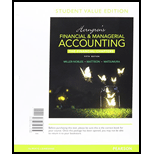
1.
Trading Investments:
Trading investments are the investments in debt or equity securities where the investor holds less than 20% of the voting stock. The investor wishes to sell these investments at a short notice like in a few days, week, or months to generate some profit out of it. They are treated as current assets.
Available-for-sale investments:
Available-for-sale investments are the investments in debt or equity securities, where the investor wishes to holds less than 20% of voting stock, and neither referred as trading or hold-to-maturity investments. For debt securities, the investor do not wish to hold it till maturity, and hence reported either as current assets or as long-term assets in the
Unrealized-gain or Unrealized-loss:
Unrealized-holding gain or loss occurs when the investor company record the investments at its fair value, in its financial statements, without disposing (selling) them. When the cost of the investment is lesser than the fair value of the investment, then it is unrealized-gain. On the contrary, when the cost of the investment is greater than the fair value of the investment, then it is unrealized-loss.
To list out: The classifications of debt and/or equity security investments do the Corporation S hold.
2.
To give: The breakdown of the short-term and long-term investments of Corporation S held at September 29, 2013.
3.
To identify: Each item related to the company’s debt and equity security investments, the amount of the item, and the section of the cash flow statement in which the item appears.
4.
To identify: The way in which Corporation S’s available-for-sale investments and trading investments reported.
Want to see the full answer?
Check out a sample textbook solution
Chapter 10 Solutions
Horngren's Financial & Managerial Accounting, The Financial Chapters (Book & Access Card)
- Degregorio Corporation makes a product that uses a material with the following direct material standards: Standard quantity 4 kilos per unit Standard price $9 per kilo The company produced 7,200 units in November using 29,290 kilos of the material. During the month. the company purchased 31,480 kilos of the direct material at a total cost of $277,024. The direct materials purchases variance is computed when the materials are purchased. The materials price variance for November is: a. $5,592 F b. $5,592 U c. $6,296 F d. $6,296 Uarrow_forwardNonearrow_forwardSelect the correct equation format for the purchases budget. a. Beginning inventory + expected sales = required purchases b. Expected sales + Desired ending inventory = required purchases c. Beginning inventory + expected sales - desired ending inventory = required purchases d. Expected sales + desired ending inventory - beginning inventory = required purchasesarrow_forward
- please give me correct answer general accountingarrow_forwardA hardware store has budgeted sales of $46,000 for its power tools in August. Management wants to have $8,000 in power tool inventory at the end of August. Its beginning inventory is expected to be $5,000. What is the budgeted amount of merchandise purchases?arrow_forwardA company is considering whether to classify certain expenses as operating expenses or non-operating expenses. Discuss the potential impact of this classification on the company's financial statements and key ratios. What factors should the company consider when making this decision? How can the company ensure consistency in its expense classification? NO WRONG ANSWERarrow_forward
- provide correct answer general accounting questionarrow_forwardDo fast answer of this accounting questionsarrow_forwardWhich of the following formulas best describes the merchandise purchases budgets? a. Inventory to purchase = Budgeted ending inventory plus the budgeted cost of sales plus budgeted beginning inventory. b. Inventory to purchase = Budgeted beginning inventory plus the budgeted cost of sales less budgeted ending inventory. c. Inventory to purchase = Budgeted beginning inventory plus the budgeted cost of sales plus budgeted ending inventory. d. Inventory to purchase = Budgeted ending inventory plus the budgeted cost of sales less budgeted beginning inventory.arrow_forward
 Financial AccountingAccountingISBN:9781337272124Author:Carl Warren, James M. Reeve, Jonathan DuchacPublisher:Cengage Learning
Financial AccountingAccountingISBN:9781337272124Author:Carl Warren, James M. Reeve, Jonathan DuchacPublisher:Cengage Learning Cornerstones of Financial AccountingAccountingISBN:9781337690881Author:Jay Rich, Jeff JonesPublisher:Cengage Learning
Cornerstones of Financial AccountingAccountingISBN:9781337690881Author:Jay Rich, Jeff JonesPublisher:Cengage Learning Intermediate Accounting: Reporting And AnalysisAccountingISBN:9781337788281Author:James M. Wahlen, Jefferson P. Jones, Donald PagachPublisher:Cengage Learning
Intermediate Accounting: Reporting And AnalysisAccountingISBN:9781337788281Author:James M. Wahlen, Jefferson P. Jones, Donald PagachPublisher:Cengage Learning Managerial Accounting: The Cornerstone of Busines...AccountingISBN:9781337115773Author:Maryanne M. Mowen, Don R. Hansen, Dan L. HeitgerPublisher:Cengage Learning
Managerial Accounting: The Cornerstone of Busines...AccountingISBN:9781337115773Author:Maryanne M. Mowen, Don R. Hansen, Dan L. HeitgerPublisher:Cengage Learning Financial Accounting: The Impact on Decision Make...AccountingISBN:9781305654174Author:Gary A. Porter, Curtis L. NortonPublisher:Cengage Learning
Financial Accounting: The Impact on Decision Make...AccountingISBN:9781305654174Author:Gary A. Porter, Curtis L. NortonPublisher:Cengage Learning Managerial AccountingAccountingISBN:9781337912020Author:Carl Warren, Ph.d. Cma William B. TaylerPublisher:South-Western College Pub
Managerial AccountingAccountingISBN:9781337912020Author:Carl Warren, Ph.d. Cma William B. TaylerPublisher:South-Western College Pub





